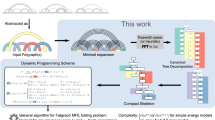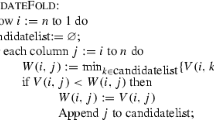Abstract
We extend an hypergraph representation, introduced by Finkelstein and Roytberg, to unify dynamic programming algorithms in the context of RNA folding with pseudoknots. Classic applications of RNA dynamic programming (Energy minimization, partition function, base-pair probabilities…) are reformulated within this framework, giving rise to very simple algorithms. This reformulation allows one to conceptually detach the conformation space/energy model – captured by the hypergraph model – from the specific application, assuming unambiguity of the decomposition. To ensure the latter property, we propose a new combinatorial methodology based on generating functions. We extend the set of generic applications by proposing an exact algorithm for extracting generalized moments in weighted distribution, generalizing a prior contribution by Miklos and al. Finally, we illustrate our full-fledged programme on three exemplary conformation spaces (secondary structures, Akutsu’s simple type pseudoknots and kissing hairpins). This readily gives sets of algorithms that are either novel or have complexity comparable to classic implementations for minimization and Boltzmann ensemble applications of dynamic programming.
Access this chapter
Tax calculation will be finalised at checkout
Purchases are for personal use only
Preview
Unable to display preview. Download preview PDF.
Similar content being viewed by others
References
Akutsu, T.: Dynamic programming algorithms for RNA secondary structure prediction with pseudoknots. Discrete Appl. Math. 104(1-3), 45–62 (2000)
Alkan, C., Karakoç, E., Nadeau, J.H., Şahinalp, S.C., Zhang, K.: RNA-RNA Interaction Prediction and Antisense RNA Target Search. In: Miyano, S., Mesirov, J., Kasif, S., Istrail, S., Pevzner, P.A., Waterman, M. (eds.) RECOMB 2005. LNCS (LNBI), vol. 3500, pp. 152–171. Springer, Heidelberg (2005)
Andronescu, M., Fejes, A.P., Hutter, F., Hoos, H.H., Condon, A.: A New Algorithm for RNA Secondary Structure Design. J. Mol. Biol. 336(3), 607–624 (2004)
Bekaert, M., Bidou, L., Denise, A., Duchateau-Nguyen, G., Forest, J., Froidevaux, C., Hatin, I., Rousset, J., Termier, M.: Towards a computational model for – 1 eukaryotic frameshifting sites. Bioinformatics 19, 327–335 (2003)
Bousquet-Mélou, M., Ponty, Y.: Culminating paths. Discrete Mathematics and Theoretical Computer Science 10(2), 125–152 (2008)
Cao, S., Chen, S.J.: Predicting RNA pseudoknot folding thermodynamics. Nucleic Acids Res. 34(9), 2634–2652 (2006)
Cao, S., Chen, S.J.: Predicting structured and stabilities for H-type pseudoknots with interhelix loop. RNA 15, 696–706 (2009)
Chen, H.L., Condon, A., Jabbari, H.: An O(n(5)) algorithm for MFE prediction of kissing hairpins and 4-chains in nucleic acids. Journal of Computational Biology 16(6), 803–815 (2009)
Condon, A., Davy, B., Rastegari, B., Zhao, S., Tarrant, F.: Classifying RNA pseudoknotted structures. Theoretical Computer Science 320(1), 35–50 (2004)
Denise, A., Ponty, Y., Termier, M.: Controlled non uniform random generation of decomposable structures. Theoretical Computer Science 411(40-42), 3527–3552 (2010)
Ding, Y., Chan, C.Y., Lawrence, C.E.: RNA secondary structure prediction by centroids in a boltzmann weighted ensemble. RNA 11, 1157–1166 (2005)
Ding, Y., Lawrence, E.: A statistical sampling algorithm for RNA secondary structure prediction. Nucleic Acids Res. 31(24), 7280–7301 (2003)
Dirks, R., Pierce, N.: A partition function algorithm for nucleic acid secondary structure including pseudoknots. J. Comput. Chem. 24, 1664–1677 (2003)
Do, C.B., Woods, D.A., Batzoglou, S.: CONTRAfold: RNA secondary structure prediction without physics-based models. Bioinformatics 22(14), e90–e98 (2006)
Ferrè, F., Ponty, Y., Lorenz, W.A., Clote, P.: DIAL: A web server for the pairwise alignment of two RNA 3-dimensional structures using nucleotide, dihedral angle and base pairing similarities. Nucleic Acids Res. 35 (Web server issue), W659–W668 (July 2007)
Finkelstein, A.V., Roytberg, M.A.: Computation of biopolymers: a general approach to different problems. Biosystems 30(1-3), 1–19 (1993)
Flajolet, P., Zimmermann, P., Van Cutsem, B.: Calculus for the random generation of labelled combinatorial structures. Theoretical Computer Science 132, 1–35 (1994), a preliminary version is available in INRIA Research Report RR-1830
Flajolet, P.: Analytic models and ambiguity of context-free languages. Theoretical Computer Science 49, 283–309 (1987)
Giegerich, R.: A systematic approach to dynamic programming in bioinformatics. Bioinformatics 16(8), 665–677 (2000)
Hamada, M., Kiryu, H., Sato, K., Mituyama, T., Asai, K.: Prediction of RNA secondary structure using generalized centroid estimators. Bioinformatics 25(4), 465–473 (2009)
Harmanci, A.O., Sharma, G., Mathews, D.H.: Stochastic sampling of the rna structural alignment space. Nucleic Acids Res. 37(12), 4063–4075 (2009)
Hofacker, I.L.: Vienna RNA secondary structure server. Nucleic Acids Res. 31(13), 3429–3431 (2003)
Huang, F.W.D., Peng, W.W.J., Reidys, C.M.: Folding 3-noncrossing rna pseudoknot structures. J. Comput. Biol. 16(11), 1549–1575 (2009)
Huang, F.W.D., Qin, J., Reidys, C.M., Stadler, P.F.: Target prediction and a statistical sampling algorithm for RNA-RNA interaction. Bioinformatics 26(2), 175–181 (2010)
Kucherov, G., Noe, L., Ponty, Y.: Estimating seed sensibility on homogenous alignments. In: IEEE (ed.) Proceedings of Fourth IEEE Symposium on Bioinformatics and Bioengineering (BIBE 2004), p. 387 (2004)
Lefebvre, F.: A grammar-based unification of several alignment and folding algorithms. In: Proceedings of the Fourth International Conference on Intelligent Systems for Molecular Biology, pp. 143–154. AAAI Press, Menlo Park (1996)
Lefebvre, F.: Grammaires S-attribuées multi-bandes et applications à l’analyse automatique de séquences biologiques. Ph.D. thesis, École Polytechnique (1997)
Lescoute, A., Westhof, E.: Topology of three-way junctions in folded RNAs. RNA 12(1), 83–93 (2006)
Lorenz, W., Ponty, Y., Clote, P.: Asymptotics of RNA shapes. Journal of Computational Biology 15(1), 31–63 (2008)
Lyngsø, R.B., Pedersen, C.N.S.: RNA pseudoknot prediction in energy-based models. Journal of Computational Biology 7(3-4), 409–427 (2000)
Markham, N.R.: Algorithms and software for nucleic acid sequences. Ph.D. thesis, Faculty of Rensselaer Polytechnic Institute (2006)
Markham, N.R., Zuker, M.: UNAFold: software for nucleic acid folding and hybridization. Methods Mol. Biol. 453, 3–31 (2008)
Mathews, D.H.: Using an RNA secondary structure partition function to determine confidence in base pairs predicted by free energy minimization. RNA 10(8), 1178–1190 (2004)
Mathews, D., Sabina, J., Zuker, M., Turner, D.: Expanded sequence dependence of thermodynamic parameters improves prediction of RNA secondary structure. J. Mol. Biol. 288, 911–940 (1999)
McCaskill, J.: The equilibrium partition function and base pair binding probabilities for RNA secondary structure. Biopolymers 29, 1105–1119 (1990)
Mückstein, U., Hofacker, I.L., Stadler, P.F.: Stochastic pairwise alignments. Bioinformatics 18(suppl. 2), S153–S160 (2002)
Möhl, M., Will, S., Backofen, R.: Lifting prediction to alignment of rna pseudoknots. J. Comput. Biol. 17(3), 429–442 (2010), http://dx.doi.org/10.1089/cmb.2009.0168
Miklós, I., Meyer, I.M., Nagy, B.: Moments of the boltzmann distribution for RNA secondary structures. Bull. Math. Biol. 67(5), 1031–1047 (2005)
Nussinov, R., Jacobson, A.B.: Fast algorithm for predicting the secondary structure of single stranded RNA. Proc. Natl. Acad. Sci. USA 77(11), 6309–6313 (1980)
Parisien, M., Major, F.: The MC-Fold and MC-Sym pipeline infers RNA structure from sequence data. Nature 452(7183), 51–55 (2008)
Ponty, Y.: Efficient sampling of RNA secondary structures from the boltzmann ensemble of low-energy: The boustrophedon method. J. Math. Biol. 56(1-2), 107–127 (2008)
Reeder, J., Giegerich, R.: Design, implementation and evaluation of a practical pseudoknot folding algorithm based on thermodynamics. BMC Bioinformatics 5, 104 (2004)
Reeder, J., Steffen, P., Giegerich, R.: Effective ambiguity checking in biosequence analysis. BMC Bioinformatics 6, 153 (2005)
Reidys, C.M., Huang, F.W.D., Andersen, J.E., Penner, R.C., Stadler, P.F., Nebel, M.E.: Topology and prediction of rna pseudoknots. Bioinformatics 27(8), 1076–1085 (2011)
Rivas, E., Eddy, S.: A dynamic programming algorithm for RNA structure prediction including pseudoknots. J. Mol. Biol. 285, 2053–2068 (1999)
Sankoff, D.: Simultaneous solution of the rna folding, alignment and protosequence problems. SIAM J. Appl. Math. 45, 810–825 (1985)
Saule, C.: Modèles combinatoires des structures d’ARN avec ou sans pseudonoeuds, application à la comparaison de structures. Ph.D. thesis, Université Paris Sud, Ecole doctorale informatique (December 2010)
Saule, C., Régnier, M., Steyaert, J.M., Denise, A.: Counting RNA pseudoknotted structures. Journal of Computational Biology (to appear)
Thachuk, C., Manuch, J., Rafiey, A., Mathieson, L.A., Stacho, L., Condon, A.: An algorithm for the energy barrier problem without pseudoknots and temporary arcs. In: Pac. Symp. Biocomput., pp. 108–119 (2010)
Theis, C., Janssen, S., Giegerich, R.: Prediction of RNA secondary structure including kissing hairpin motifs. In: Moulton, V., Singh, M. (eds.) WABI 2010. LNCS, vol. 6293, pp. 52–64. Springer, Heidelberg (2010)
Tinoco, I., Borer, P.N., Dengler, B., Levin, M.D., Uhlenbeck, O.C., Crothers, D.M., Bralla, J.: Improved estimation of secondary structure in ribonucleic acids. Nat. New. Biol. 246(150), 40–41 (1973)
Vernizzi, G., Ribeca, P., Orland, H., Zee, A.: Topology of pseudoknotted homopolymers. Physical Review E (Statistical, Nonlinear, and Soft Matter Physics) 73(3), 031902 (2006)
Waldispühl, J., Devadas, S., Berger, B., Clote, P.: Efficient algorithms for probing the RNA mutation landscape. PLoS Comput Biol 4(8), e1000124 (2008)
Waterman, M.S.: Secondary structure of single stranded nucleic acids. Advances in Mathematics Supplementary Studies 1(1), 167–212 (1978)
Wilf, H.S.: A unified setting for sequencing, ranking, and selection algorithms for combinatorial objects. Advances in Mathematics 24, 281–291 (1977)
Zuker, M., Stiegler, P.: Optimal computer folding of large RNA sequences using thermodynamics and auxiliary information. Nucleic Acids Res. 9, 133–148 (1981)
Author information
Authors and Affiliations
Editor information
Editors and Affiliations
Rights and permissions
Copyright information
© 2011 Springer-Verlag Berlin Heidelberg
About this paper
Cite this paper
Ponty, Y., Saule, C. (2011). A Combinatorial Framework for Designing (Pseudoknotted) RNA Algorithms. In: Przytycka, T.M., Sagot, MF. (eds) Algorithms in Bioinformatics. WABI 2011. Lecture Notes in Computer Science(), vol 6833. Springer, Berlin, Heidelberg. https://doi.org/10.1007/978-3-642-23038-7_22
Download citation
DOI: https://doi.org/10.1007/978-3-642-23038-7_22
Publisher Name: Springer, Berlin, Heidelberg
Print ISBN: 978-3-642-23037-0
Online ISBN: 978-3-642-23038-7
eBook Packages: Computer ScienceComputer Science (R0)




